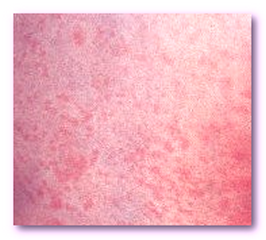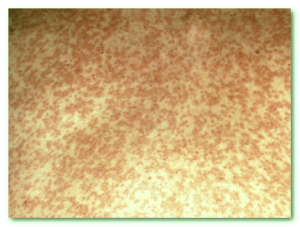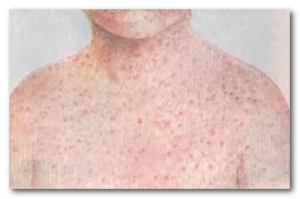Rubella rash is a symptom of rubella which is a disease caused due to infection by the rubella virus. Also referred to as 3-day measles or German measles, rubella typically affects the lymph nodes and the skin. Rubella and measles have some similar characteristics, but the infecting viruses are different. Also, rubella is not as severe or as infectious as measles.
Rubella is spread due to sharing of food or drinks with an infected person, or due to inhalation of infected fluids that are released into the air as droplets by infected people during coughing or sneezing. The virus can also pass from an expectant mother to the fetus via the bloodstream of the pregnant woman.
Rubella occurs as a minor disease in kids. However, most cases are usually found in non-immunized young adults rather than children. It is reported that about 9 percent of adults are vulnerable to developing rubella rash, which in turn increases the risk of them transferring the infection to their as yet unborn children. The main danger of rubella is the development of congenital rubella syndrome defects in babies.
Before the rubella vaccine was developed in 1969, epidemics occurred every 7 to 9 years, often affecting 5 to 10 year olds, including many cases of congenital rubella. Such cases have dropped significantly after widespread immunizations. The MMR or measles-mumps-rubella vaccine is generally administered to children, two times, before they start attending school.
Symptoms accompanying rubella rash
The signs and symptoms that accompany rubella rash are often mild and usually not noticed, particularly in children. When symptoms are noticed, then they often occur 2 to 3 weeks after getting infected by the virus. The symptoms generally last for 2 to 3 days and may include:
- The infection may start with mild fever, between 99 and 100 F and which lasts for 1 or 2 days, along with tender and swollen lymph nodes normally affecting behind the ears and at the back of the neck.
- Later, a rash will form on the face and migrate downwards, to the torso, arms, and legs. This rubella rash is often the first easily visible sign of the infection. When the rash spreads, it generally clears from the face.
- Rubella rash may look like any other viral rash and may occur as light red or pink spots that often assimilate to develop into evenly colored abnormal patches on skin. The rash may persist for nearly 3 days and cause itchiness. The affected skin area tends to shed very thin flakes when the rash clears.
- Other symptoms that may accompany rubella rash, particularly in adults in teens, include loss of appetite, headaches, runny or stuffy nose, mild pink eye, swollen or inflamed lymph nodes in other body areas, and swelling and pain in the joints, particularly in younger women. Some affected women may develop arthritis in the wrists, fingers, and knees that lasts for about a month.
- Rarely, rubella may cause encephalitis or brain inflammation, and/or otitis media or ear infections.
Rubella in expectant mothers can lead to the development of congenital rubella syndrome, which can be extremely detrimental for the unborn child. Affected children are at increased risk to experiencing intellectual deficits, deafness, growth issues, ocular and cardiac defects, and spleen, liver, and bone marrow anomalies.
Many affected adults may show nil or very few symptoms.
Causes of rubella rash
The rubella virus tends to spread via direct contact with the respiratory secretions of an infected person, or via contact with the infected droplets released into the air by the patient during coughs and sneezes, or via sharing of beverages and foods with an infected person. The virus tends to remain most contagious from 1 week before the rubella rash makes an appearance till a week or two after it has cleared out. A person who does elicit any symptoms may still be capable of spreading the virus. The virus can also be transmitted from an expectant woman to the fetus via her bloodstream.
Babies with congenital rubella syndrome may eliminate the virus via nasal or throat fluids or their urine for nearly 1 year or even more. Thus, the virus can transmit to non-immunized people who come into contact with such infants.
Rubella rash infection is mild and people usually develop immunity to it once they have developed it. Most children in the US get vaccinated against rubella at an early age. However, it may be seen in foreign-born unvaccinated adults. Also, the disease is prevalent in many other countries. Hence, Americans, especially pregnant women, need to take this fact into account before travelling to other nations.
- Rubella rash virus incubation: Rubella virus has an incubation period of 14 to 24 days, with the average being 16 to 19 days. Thus, children will get rubella only 2 to 3 weeks after getting exposed to the virus.
- Rubella rash virus duration: Rubella rash usually persists for 3 to 4 days. Swelling of the lymph nodes may continue for 7 days or more, while pain in joints may persist for 2 weeks or more. Affected children generally recover in about a week, while the illness may last longer in adults.
Treatment of rubella rash
No treatment can shorten the duration of rubella rash infection. The condition clears out on its own. Patients need to be kept in isolation and bed rest is recommended. Fever needs to be monitored; if it climbs too high then seek medical attention. Ibuprofen or acetaminophen may be given to ease discomfort. Aspirin should not be given to children as it carries the risk of Reye syndrome development.
Pregnant women who develop rubella need to consult a doctor for varied options. If the pregnancy is continued, then hyperimmune globulin antibodies are given to fight the infection. It helps alleviate the symptoms, but may not totally eliminate the chances of the child developing congenital rubella syndrome. Children with congenital rubella syndrome may require treatment from a variety of specialists as per the severity of the condition.
The MMR vaccine helps prevent the infection. It is usually administered when the child is 12 to 15 months old, and again between four to six years of age. Children between 6 to 8 months get the immunity of their mothers and hence are protected from rubella rash viral infection. Children can be given the vaccine before 12 months of age, as early as 6 months old, for reasons such as foreign travel. Such children also need to be vaccinated again as mentioned above.
Rubella Rash – Pictures



